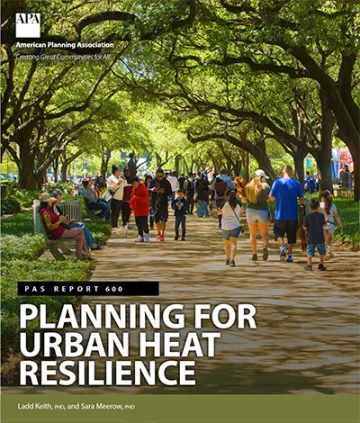Planning for Urban Heat Resilience: Professor Ladd Keith Partners with American Planning Association on Essential Publication

The Brown Foundation Promenade is a limestone path shaded by majestic 100-year-old oak trees that forms the heart of Discovery Green, a 12-acre park in downtown Houston. Remnants of an early residential neighborhood, the trees were surrounded by concrete parking lots until Houston philanthropists led the creation of a transformative public park, which opened in 2008. Photo by Katya Horner, courtesy American Planning Association.
Heat is the number one weather-related killer in the United States, say University of Arizona Assistant Professor of Planning and Sustainable Built Environments Ladd Keith and Arizona State University Assistant Professor of Geographical Sciences and Urban Planning Sara Meerow. And with the continuing rise of average global temperatures, the threats of extreme heat events and chronic heat are projected to increase.

Thanks to a partnership with the American Planning Association, Keith and Meerow have published a comprehensive guide for planners and their communities to equitably prepare for urban heat resilience and mitigation: Planning for Urban Heat Resilience. The Planning Advisory Service report, funded in part by the National Oceanic and Atmospheric Administration’s Extreme Heat Risk Initiative, is now available for free download.
“We hope this is a helpful resource for both those addressing heat for the first time and those interested in advancing their current heat planning efforts,” says Keith.
The 98-page report, which begins with an urban heat resilience infographic, discusses the impacts and growing risks of urban heat while contextualizing the complexities of urban heat, from climate change and the urban heat island (UHI) effect to governing urban heat and important heat information sources.
It also discusses equity and urban heat and the need to plan for “heat equity,” which Keith and Meerow define as “the development of practices and policies to mitigate and manage heat with a focus on reducing the inequitable distribution of risk across different groups within the same community.”
After establishing an urban heat resilience planning framework—which begins with setting urban heat goals and ends with implementation and monitoring—the researchers lay out several heat mitigation and heat management strategies, from land-use planning, urban design, urban greening and waste heat reduction for heat mitigation to energy, personal exposure, public health and emergency preparedness for heat management.
Keith and Meerow also provide planning tools for urban heat resilience within the categories of community visioning and engagement, plans and policies, regulations and project review, and public investments.
The publication concludes with the researchers’ recommendations on advancing urban heat resilience, from what we know and don’t know to priority areas for further evaluation and research, ending in a decisive call to action.
“Heat poses a growing and inequitable threat,” write Keith and Meerow. “Cities around the world must plan now to increase urban heat resilience in the face of climate change and the urban heat island effect. Planners are well positioned to use existing regulatory tools and plans to mitigate the inequitably distributed risk associated with the UHI effect, reduce greenhouse gas emissions contributing to climate change and help prepare for extreme heat events.”
In Planning for Urban Heat Resilience, Keith and Meerow and the American Planning Association have equipped planners with the background knowledge, planning framework and catalog of comprehensive approaches to heat mitigation and management they need to work effectively with colleagues across agencies and sectors and advanced urban heat resilience in their communities.
Learn more and download Planning for Urban Heat Resilience now.



